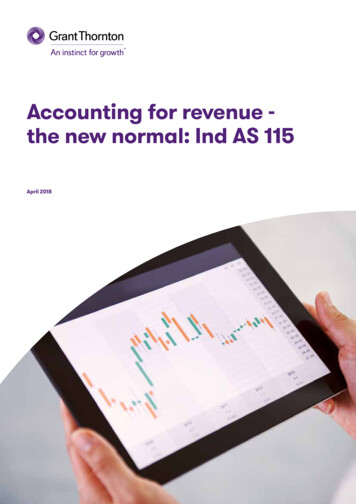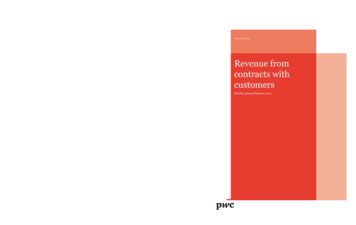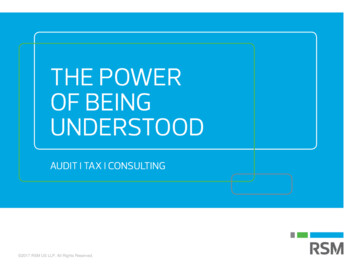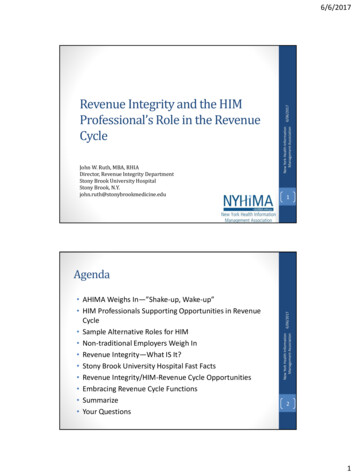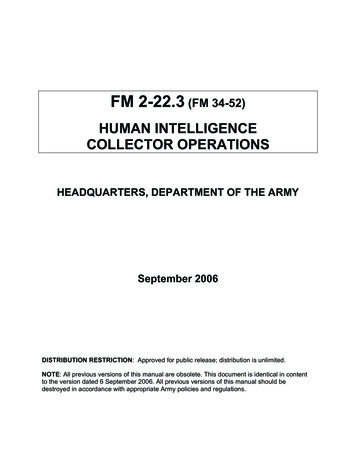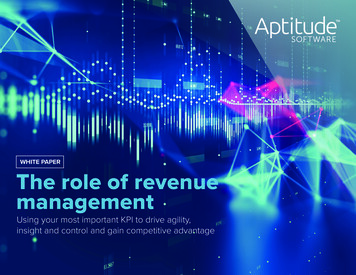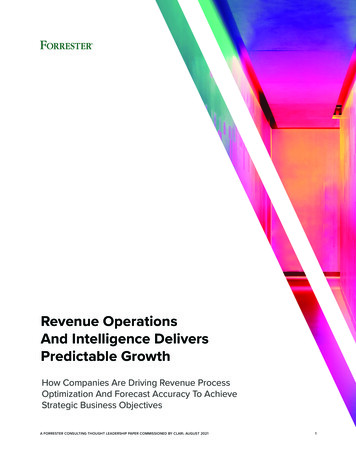
Transcription
Revenue OperationsAnd Intelligence DeliversPredictable GrowthHow Companies Are Driving Revenue ProcessOptimization And Forecast Accuracy To AchieveStrategic Business ObjectivesA FORRESTER CONSULTING THOUGHT LEADERSHIP PAPER COMMISSIONED BY CLARI, AUGUST 20211
Table of ContentsExecutive SummaryKey Findings 3 4Revenue Process Optimization And PredictableRevenue Are Critical To Business Growth 5The Trouble With Forecasting 8Technology Roadblocks On The RoadTo Optimizing The Revenue Engine 11RO&I Solutions Can Improve Forecast AccuracyAnd Process Optimization 13RO&I Solutions Maximize The PotentialOf The Revenue Engine 17Key Recommendations 19Appendix A: Methodology 21Appendix B: Demographics 21Appendix C: Supplemental MaterialProject Director:Andrew Magarie,Principal Market Impact Consultant 21Contributing Research:Forrester’s Infrastructure &Operations research groupABOUT FORRESTER CONSULTINGForrester Consulting provides independent and objective research-based consulting to help leaders succeed in theirorganizations. Ranging in scope from a short strategy session to custom projects, Forrester’s Consulting services connectyou directly with research analysts who apply expert insight to your specific business challenges. For more information,visit forrester.com/consulting. Forrester Research, Inc. All rights reserved. Unauthorized reproduction is strictly prohibited. Information is based on thebest available resources. Opinions reflect judgment at the time and are subject to change. Forrester , Technographics ,Forrester Wave, RoleView, TechRadar, and Total Economic Impact are trademarks of Forrester Research, Inc. All othertrademarks are the property of their respective companies. [E-51356]REVENUE OPERATIONS AND INTELLIGENCE DELIVERS PREDICTABLE GROWTH2
Executive SummaryA confluence of market trends, accelerating rate of business change, andempowered customers is breaking the status quo and making it moreimportant — and difficult — than ever to drive optimized, predictablerevenue. Meeting growth goals requires a combination of accurate revenueforecasting and optimized revenue processes. Unfortunately, most firmsare lacking in both, as many current customer relationship management(CRM) solutions, business intelligence (BI) tools, and manual spreadsheetslack the visibility, automation, real-time data, and insights needed tooptimize the revenue engine.To fill such gaps, revenue operations teams are turning to a new categoryof solutions that help optimize the performance of the revenue engine.These new technologies achieve this by leveraging data, signals, andinteractions between buyers and sellers (revenue intelligence) to analyzeand then optimize revenue workflows such as forecasting, pipelinemanagement, and sales performance (revenue operations). These revenueoperations and intelligence (RO&I) solutions allow companies to maximizethe potential of their revenue engine, with proven impact on key drivers oftop- and bottom-line performance such as forecast accuracy, performancemanagement, and improved productivity.In April 2021, Clari commissioned Forrester Consulting to evaluate thecurrent state of revenue operations at high-growth companies. Forresterconducted an online survey with 327 revenue operations decision-makersat US software and technology companies to explore this topic.Key FindingsREVENUE OPERATIONS AND INTELLIGENCE DELIVERS PREDICTABLE GROWTH3
Key FindingsMeeting growth goals requires an optimized revenueengine. In high-growth markets, companies require newlevels of insight, orchestration, and alignment acrossthe key processes of the revenue engine to achievetheir companywide strategic initiatives. To achieve this,companies must look for technology solutions to helpdrive predictable revenue at scale. Companies using RO&Isolutions are seeing significant optimization benefits,with 59% seeing improved win rates and 53% reportingincreased net-dollar retention.RO&I solutions enable business predictability. In volatilebusiness environments where revenue leaders mustproactively manage internal and external stakeholderexpectations, consistent revenue predictability separatesbest-in-class from the rest. Companies using RO&I solutionsare almost three times more likely to forecast with 95% accuracy on a monthly time frame. That type of predictabilityhas a significant impact on executive perceptions ofoperations reliability, allowing leadership to make strategicdecisions and investments with confidence.RO&I solutions drive improved revenue growth. RO&Isolutions allow companies to achieve their growthobjectives by delivering a common view of the driversof revenue performance that enables alignment,accountability, and cross-functional collaboration.Companies adopting RO&I solutions are reaping thebenefits, with 41% reporting major quantifiable revenuebenefits and 69% seeing revenue benefits overall.REVENUE OPERATIONS AND INTELLIGENCE DELIVERS PREDICTABLE GROWTH4
Revenue Process Optimization And Predictable RevenueAre Critical To Business GrowthEvery company has a set of strategic growth initiatives that leadership usesto rally the entire go-to-market organization. These initiatives can includeimproving customer retention, organic expansion into new markets (bothhorizontal and vertical), inorganic growth through mergers and acquisitions,or raising new rounds of funding by filing for IPOs or with private equity.Recent global volatility has made new customer acquisition morechallenging and forced shifts in target segments as some struggled whileothers blossomed. These challenges highlighted the significance inparticular of two key organizational capabilities: Optimizing customer retention. The most common growth initiative inthe next one to three years cited by our respondents is the optimizationof customer retention or cross-sell processes (see Figure 1). Adapting to market shifts. More than half of survey respondentsindicated that they are planning to expand into new markets as part oftheir growth and strategic initiatives in the next three years.Figure 1“Which of the following are key growth/strategic initiatives for your organizationin the next one to three years?”Optimizing customer retentionor cross-sell processes53%Expanding into new geographiesor vertical markets51%Preparing for anIPO/sale/private equity44%Fundraising(private equity or VC)42%Launching new product lines40%Expanding through M&A37%Base: 327 software industry revenue operations decision-makersSource: A commissioned study conducted by Forrester Consulting on behalf of Clari, April 2021REVENUE OPERATIONS AND INTELLIGENCE DELIVERS PREDICTABLE GROWTH5
Achieving these growth initiatives requires a level of orchestration,alignment, and agility at all levels and across all go-to-market functions inthe organization. Two capabilities are key to making this a reality: Revenue process and execution optimization. Two-thirds of surveyrespondents said revenue process optimization is important toachieving their customer retention goals, and 63% said it is important toadapting to new market expansion. Revenue forecast accuracy. Seventy-two percent of respondents sayaccurate revenue forecasts are important for optimizing customerretention, and two-thirds say the same of new market expansion.Technology has a key role to play in enabling these capabilities across thego-to-market organization by allowing companies to understand how theyinteract with buyers and then use those insights to adapt and optimize allof the related processes in the revenue engine.Two-thirds of survey respondents said revenueprocess optimization is important to achievingtheir customer retention goals, and 63% said it isimportant to adapting to new market expansion.THE REVENUE ORGANIZATION IS EXPANDINGThe data from the survey highlights the reality of modern revenueoperations: It takes a village. Delivering on key strategic initiatives requirestight alignment and clear accountability across multiple functions involvedalong the revenue process (see Figure 2). The days of siloed operationsare over. These functions have common needs for insights around revenuepredictions, buyer interaction, and risk at both the account and opportunitylevel. Supporting technology must be architected for this extendedrevenue team and the functions within it, not just for one.REVENUE OPERATIONS AND INTELLIGENCE DELIVERS PREDICTABLE GROWTH6
Figure 2“Who are the primary stakeholders involved in each of the followingrevenue tasks or processes?”(Select all that apply)Sales/account managementMarketingCustomer successFinance48%22%29%34%Account planning t strategy29%19%Churn/renewal forecasting49%26%26%Pipeline generation27%34%26%18%Pipeline inspection46%20%28%29%Identifying revenue leakage28%Opportunity management41%31%25%43%35%22%33%35%25%39%24%New logo revenue forecastingBase: 327 software industry revenue operations decision-makersSource: A commissioned study conducted by Forrester Consulting on behalf of Clari, April 2021REVENUE OPERATIONS AND INTELLIGENCE DELIVERS PREDICTABLE GROWTH7
The Trouble With ForecastingWhile sales forecasting is a critical capability todeliver the growth required to meet strategic goals,the fact is that most B2B companies’ forecastsare not very accurate — and worse, they may notrealize it. Fifty-five percent of respondents said theymiss their quarterly forecast on average by morethan 10% (51% say the same for monthly forecasts).Compounding this challenge, a changing businessenvironment will only make accurate forecastingmore difficult in the future. Our survey shows: 55%of respondents saidthey miss their quarterlyforecast on average bymore than 10%.While most firms think they are accurate,the majority miss the mark. Almost all therespondents in our survey say they aremeasuring the accuracy of their forecasts. Further, the majority of theserespondents believe their forecasting capabilities are mature. However,only 18% of respondents say their quarterly forecasts are within 5% oftheir actual revenue, dropping to 15% for monthly forecasts (see Figure3). In fact, more firms are off on their forecasts by 20% or more than arewithin that ideal 5% range.Figure 3“How accurate are your revenue forecasts from the first milestone measurementearly in the time period to actual revenue reported on the following timeframes?”100% accurateOff by /- 1% to 5%Off by /- 6% to 10%Off by /- 11% to 20%Off by more than /- 20%Don’t know/Don’t forecastAnnual forecastQuarterly forecast4%6%14%4%5%31%28%2%3%12%13%17%Monthly forecast19%22%24%33%32% 32%Base: 303 software industry revenue operations decision-makers who measure the accuracy of their revenue forecastsSource: A commissioned study conducted by Forrester Consulting on behalf of Clari, April 2021REVENUE OPERATIONS AND INTELLIGENCE DELIVERS PREDICTABLE GROWTH8
Increasing complexity and volatility makeforecasting tougher. Most survey respondentsindicated that there are several current trendsthat will make accurate forecasting more difficultin the future. Trends like accelerating ratesof business change (58% say this will makeforecasting more difficult), increasing buyerjourney complexity (56%) and new revenuemodels (51%) all increase forecasting complexityand volatility, making capabilities like realtime data, visibility across lines of business,and workflow automation essential to drivingaccurate forecasting.Roughly1 in 3respondents indicatethat ineffectivetechnology is a causeof forecast variability attheir organizations. Gaps in technology exacerbate the problem. Roughly one inthree respondents indicate that ineffective technology is a causeof forecast variability at their organizations. These technologychallenges can also cause or be compounded by additional datarelated challenges, like reliance on manual processes or bad databeing used for forecasting. Future revenue solutions must solvethese challenges through a combination of revenue intelligence,workflow automation, and the use of real-time data. The impact of poor forecasting cascades through the organization.Missing the forecast has a range of negative implications fororganizations (see Figure 4). Internally, a forecast miss can causecapacity-planning issues leading to either increased costs orfuture budget and resource restrictions — 89% of respondentsselected at least one of these outcomes as a result of poorforecasting. Externally, a forecast miss may damage the reputationand perception of the organization, its leaders, and its overallvalue, which can hamper a company’s ability to invest in growthand potentially even drive down valuations. Both internally andexternally, this erodes trust in corporate and functional leadershipleading to manager, and eventually, rep turnover.REVENUE OPERATIONS AND INTELLIGENCE DELIVERS PREDICTABLE GROWTH9
Figure 4“What are the business implications of missing your number?”Capacity planning failure54%Increased carry costfor inventory42%Tightening of budgetand resources42%Erosion of trust incorporate leadership37%Erosion of trust insales leadershipLess ability to invest in thegrowth of the businessNegative impact onmarket valuationLess ability to attractcapital investment35%89%At least one internaloperations issue62%At least onetrust issue30%26%62%At least one broaderbusiness issue25%Base: 327 software industry revenue operations decision-makersSource: A commissioned study conducted by Forrester Consulting on behalf of Clari, April 2021REVENUE OPERATIONS AND INTELLIGENCE DELIVERS PREDICTABLE GROWTH10
Technology Roadblocks On The Road To OptimizingThe Revenue EngineIn addition to accurate forecasting, the ability to measure, manage, andoptimize performance of the end-to-end revenue engine is the other keycapability in driving growth. Respondents ranked identifying revenueleakage (churn), a critical part of revenue process optimization, as therevenue task with the highest value to the business. As with forecasting,most respondents we surveyed rate their revenue process and executionoptimization capabilities highly — in fact seven in 10 say they are mature,but a closer examination reveals: Current solutions are not solving optimization challenges. A balancedrevenue engine is predicated on the ability to effectively get visibilityinto and manage all relevant revenue motions, not just the acquisitionof new logos. The ability to monitor the health of existing clientrelationships and proactively identify churn risk is key for driving upretention rates. At the same time, organizations need to be able toidentify white-space opportunities for cross-sell and upsell. However,most of our survey respondents say they struggle with these keymotions given their current technology stack (see Figure 5).Figure 5“Given your current revenue technologies, how challenging are the following?”Very challengingChallengingUnderstanding cross-sell whitespacein existing accountsTracking renewal revenue and churn17%19%Visibility into current-quarter pipelineLeveraging real-time data forrevenue prediction/optimizationOperationalizing go-to-marketstrategy based on revenue insightsVisibility into future-quarters pipeline21%18%16%17%39%32%29%31%33%30%Base: 327 software industry revenue operations decision-makersSource: A commissioned study conducted by Forrester Consulting on behalf of Clari, April 2021REVENUE OPERATIONS AND INTELLIGENCE DELIVERS PREDICTABLE GROWTH11
Many respondents lack crucial optimization capabilities. To befully effective, revenue process optimization requires both revenueintelligence insights and the ability to robustly and automaticallycapture the interactions and activities that are the raw material of suchinsights. Unfortunately, many organizations we surveyed are missingthese key capabilities. Just 26% of respondents say they are usingbusiness intelligence to support revenue processes, and only one infour have CRM automation or sales force automation (SFA) capabilities.Reliance on manual data entry causes problems in enabling real-timeviews of performance both at the individual seller and revenue teamlevel. For example, the lack of automation in capturing the interactionsand activity between buyers and sellers during the sales cycle hasbroad implications for multiple processes in the revenue engine, fromforecasting through coaching, onboarding, and the sales process.Further, only one in five respondents are using pipeline managementand buyer interaction analytics capabilities for revenue processmanagement — which respondents noted were important capabilitiesfor identifying revenue leakage and churn/renewal forecasting.REVENUE OPERATIONS AND INTELLIGENCE DELIVERS PREDICTABLE GROWTH12
RO&I Solutions Can Improve Forecast AccuracyAnd Process OptimizationTo optimize revenue execution and meet strategic goals, firms need tosolve these persistent technology challenges. To do this, firms need anRO&I solution that allows them to leverage data and insights on buyerinteractions (revenue intelligence) to drive consistent and accountablerevenue workflows across organizations (revenue execution) for taskssuch as forecasting, pipeline management, and sales performance.When compared to those without such a solution, respondents who haveadopted RO&I solutions experience: More predictable revenue. RO&I solutions deliver a major upgrade inforecasting capabilities from forecasting rooted in manual processesand spreadsheets. Users are almost three times more likely to forecastwith 95% accuracy on a monthly timeframe, and more than twice aslikely on a quarterly timeframe (see Figure 6). RO&I solution users arealso more than twice as likely to use sales forecasting capabilities tohelp them with accuracy and consistency (41% using versus 20%). Fewer challenges in revenue optimization. RO&I solution users findrevenue optimization much easier. Tracking renewals and churn is lesschallenging (45% vs 54%), while processes are more efficient (29% areless likely to say they have inefficient processes and workflows). RO&Iusers also benefit from automation (41% more likely) that drives moreaccurate and timely data while boosting rep productivity.RO&I users are almost three times morelikely to forecast with 95% accuracy on amonthly timeframe, and more than twice aslikely on a quarterly timeframe.REVENUE OPERATIONS AND INTELLIGENCE DELIVERS PREDICTABLE GROWTH13
Figure 6“How accurate are your revenue forecasts from the first milestone measurementearly in the time period to actual revenue reported on the following timeframes?”95% accuracyUsing/piloting RevOps (n 90)Not using RevOps (n 213)29%27%29%16%13%10%Monthly forecastQuarterly forecastAnnual forecastBase: 303 software industry revenue operations decision-makers who measure the accuracy of their revenue forecastsSource: A commissioned study conducted by Forrester Consulting on behalf of Clari, April 2021HIGH-GROWTH FIRMS RECOGNIZE THE IMPORTANCE OF REVENUEOPERATIONS AND INTELLIGENCE SOLUTIONSThe power of the combination of revenue intelligence plus executionoptimization is not going unnoticed by survey respondents, and many inour survey plan to invest in a RO&I solution in the near future, with 63%planning to invest in such a solution within the next three years (seeFigure 7). Not all RO&I solutions are created equal, however. The mostimportant capabilities respondents selected for such solutions include: Full visibility across lines of business. A key reason for the interestin RO&I solutions has been the ability to leverage a standardized andshared view of performance across lines of business, regions, andfunctions at each stage of the sales process. Such solutions enableeasy analysis of a broad range of revenue performance indicatorsincluding deal health, forecast probability, and buyer interaction thatdrive decision-making, accountability, and more proactive and targetedcoaching of sales resources.REVENUE OPERATIONS AND INTELLIGENCE DELIVERS PREDICTABLE GROWTH14
Workflow automation. In a world of primarilydigital interaction between sellers and buyers,buyer orchestration and sales forecastingrequire robust insights about what interactionsare taking place, with whom, and whetherthey were successful in driving forwarddeals and business relationships. A lack oftransparency into these interactions leavesorganizations blindfolded and reliant on repsto manually track activity — a long-standingsales challenge. RO&I solutions capture theseinteractions automatically and intelligentlymatch them to accounts, opportunities, andcontacts in the CRM platform, giving bothsellers and team managers visibility into how adeal is tracking. For example, machine learningalgorithms in RO&I solutions often compile andpresent engagement or deal scores basedon interaction activity, allowing comparisonof deals of a similar profile either within thecurrent pipeline or historically, and they let bothsellers and managers take proactive steps tooptimize the result.Figure 7“What are your plans to adopta revenue operations andintelligence (RO&I) solution?”Using RO&I solution nowPlanning to within 3 years30%63%Base: 327 software industry revenueoperations decision-makersSource: A commissioned study conducted byForrester Consulting on behalf of Clari, April2021 Real-time data to track revenue processes. The ability to robustlyand automatically capture buyer interactions as they happen enablesusers of RO&I solutions to leverage insights about what works andwhat doesn’t and therefore dynamically adjust deal strategy, forecastpredictions, and actions for reps. It also brings significant productivitybenefits for sellers and other customer-facing roles, who are freed fromthe burden of having to manually track interactions and can insteadapply that time to valued-added customer engagement. Insights into revenue pipeline and performance. Bookings andrevenue are outcomes or impacts of what revenue teams do or don’tdo in the sales cycle. While vital, such performance metrics come witha low level of control for leadership because they’re lagging indicators.Having full transparency into the actions and interactions that takeREVENUE OPERATIONS AND INTELLIGENCE DELIVERS PREDICTABLE GROWTH15
place between the organization and its prospects and customersprovides insights in decision-time, allowing leadership acrosssales, marketing, finance, and customer success to consider whichactivities should be prioritized by resources and how and when theyare executed.REVENUE OPERATIONS AND INTELLIGENCE DELIVERS PREDICTABLE GROWTH16
RO&I Solutions Maximize The Potential Of The Revenue EngineWith greater revenue predictability and revenueexecution optimization, RO&I users are seeinga wide range of process efficiency gains andbusiness benefits as a result of their investment(see Figure 8). These benefits include:59% Less manual work required, leading to morepredictable revenue. The combination ofof respondents seerevenue intelligence to help create consistencyimproved win/loss rates,and automation of workflows means that RO&Iand 53% report increasedusers report less manual work in their revenuenet-dollar retention.processes. Two-thirds of RO&I users say theyhave seen this benefit, with nearly four in 10reporting major quantifiable benefits in manual work reduction. Thisleads to forecasting that is less prone to human error or inaccurateassumptions: 58% of RO&I users have seen more predictable revenuesas a result of their solution. Significant internal sales benefits. RO&I users report a wide range ofsales team-related benefits as a result of their solution. These includeincreased trust in data for forecasting (67%), greater accountabilityacross the revenue organization (64%), higher quota attainment (56%),and improved sales team morale (46%). Top- and bottom-line business benefits. RO&I users see their solutionspaying dividends when it comes to their top and bottom lines. Fiftynine percent see improved win/loss rates, and 53% report increasednet-dollar retention. All of these benefits add up to increased revenuegrowth: 41% report major quantifiable revenue benefits, with 69%seeing revenue benefits overall.41% of RO&I users report major quantifiablerevenue benefits, with 69% seeing revenuebenefits overall.REVENUE OPERATIONS AND INTELLIGENCE DELIVERS PREDICTABLE GROWTH17
Figure 8“How much of a benefit, if any, has your RO&I solution had on the following goalsthat you can say with confidence you are able to measure?”Major quantifiable benefitsSome quantifiable benefitsHigher revenue growth41%Increased trust in the data weuse to forecast41%Less manual work required26%39%More accurate forecasts27%36%Increased accountability acrossthe revenue organization29%26%38%Improved ability to operationalizego-to-market strategies33%Improved win/loss rates29%28%More predictable revenue31%33%Higher quota attainment25%27%Increased net-dollar retention29%28%Faster winsImproved sales team morale28%25%31%20%18%26%Base: 327 software industry revenue operations decision-makersSource: A commissioned study conducted by Forrester Consulting on behalf of Clari, April 2021Key RecommendationsREVENUE OPERATIONS AND INTELLIGENCE DELIVERS PREDICTABLE GROWTH18
Key RecommendationsForrester’s in-depth survey of software and technology revenue operationsdecision-makers about their companies’ revenue performance yieldedseveral important recommendations:Connect technology and strategic growth initiatives.There needs to be a clear connection between your technology investmentsthat enable greater revenue engine optimization and forecast accuracywith commercial priorities of the business. RO&I solutions provide visibilityacross every line of business to the whole revenue team, allowing the entireorganization to align against companywide goals. Without this, it will bechallenging to show the business impact of these investments and garnercontinued or expanded funding.Upgrade from spreadsheets and manual processes.If you are still using spreadsheets and relying on seller opinion alone toforecast, it is time to up-level. Revenue operations and intelligence platformsaugment seller and manager forecasting and represent a major upgrade interms of accuracy, visibility, and robust management. Ensure that you arecapturing and leveraging buying signals, and in particular, buyer interactionsas part of your forecast process. Do not expect your sales reps to do thismanually: It’s a recipe for failure. These interactions provide an alternativeview of buyer behavior that reduces reliance on rep opinion alone.Interaction and activity capture is core to RO&I platforms.Ensure that your sales forecasting fundamentals are sound.Investing in developing your forecast process and capability requires a focuson four fundamentals: building a robust data and technology foundation;ensuring that the people-based processes surrounding the governance andexecution of forecasting are managed effectively; applying insights to driveaccuracy and predictability; and finally, ensuring that forecasting meets theneeds of key stakeholders who depend on reliable forecast information tomake a range of strategic and tactical decisions.REVENUE OPERATIONS AND INTELLIGENCE DELIVERS PREDICTABLE GROWTH19
Connect your strategic growth initiatives to your performance reviewcadence and operational metrics.The lack of clear connection between the strategic initiatives theorganization is driving, current technologies, and the review cadences andoperational metrics used in go-to-market functions prevents a clear causallink in measurement between what is done in sales, marketing, and customersuccess and the impact to the bottom line. Best-in-class organizations solvefor this by cascading strategic growth initiatives and the related KPIs (someorganizations may use OKRs — objectives and key results) to keep theentire go-to-market organization aligned and leverage new technologies forvisibility into progress and opportunities for optimization.REVENUE OPERATIONS AND INTELLIGENCE DELIVERS PREDICTABLE GROWTH20
Appendix A: MethodologyIn this study, Forrester conducted an online survey of 327 software industry decision-makers atorganizations in the United States to evaluate current revenue operations practices and technologies.Survey participants included decision-makers in revenue operations strategy and technology.Respondents were offered a small incentive as a thank-you for time spent on the survey. The study wascompleted in April 2021.Appendix B: DemographicsCOMPANY SIZEPOSITION/DEPARTMENT100 to 999 employees22%Finance/accounting36%1,000 to 4,999 employees42%Operations32%5,000 to 19,999 employees25%Sales17%20,000 or more employees11%General company management14%ROLEDirector48%Vice president36%C-level executive17%Note: Percentages may not total 100 because of rounding.Appendix C: Supplemental MaterialRELATED FORRESTER RESEARCH“The Future Of Sales,” Forrester Research, Inc., May 3, 2021.“The Forrester Tech Tide: Sales Technologies, Q1 2021,” Forrester Research, Inc., February 16, 2021.“Building The Business Case For A Modern Sales Enablement Toolset,” Forrester Research, Inc.,November 6, 2019.REVENUE OPERATIONS AND INTELLIGENCE DELIVERS PREDICTABLE GROWTH21
the key processes of the revenue engine to achieve their companywide strategic initiatives. To achieve this, companies must look for technology solutions to help drive predictable revenue at scale. Companies using RO&I solutions are seeing significant optimization benef


